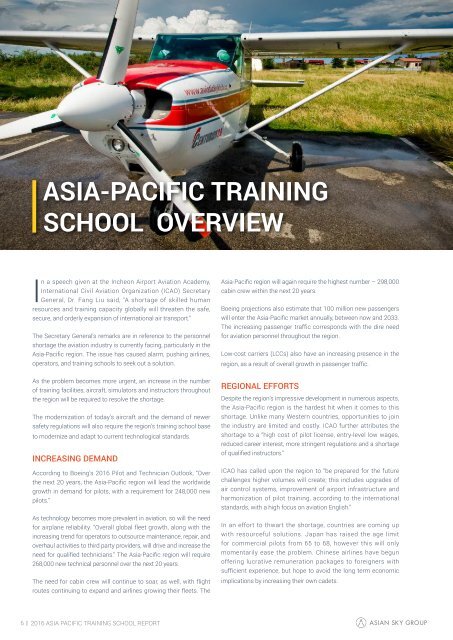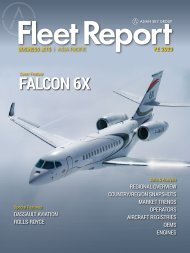You also want an ePaper? Increase the reach of your titles
YUMPU automatically turns print PDFs into web optimized ePapers that Google loves.
ASIA-PACIFIC TRAINING<br />
SCHOOL OVERVIEW<br />
In a speech given at the Incheon Airport Aviation Academy,<br />
International Civil Aviation Organization (ICAO) Secretary<br />
General, Dr. Fang Liu said, "A shortage of skilled human<br />
resources and training capacity globally will threaten the safe,<br />
secure, and orderly expansion of international air transport.”<br />
The Secretary General’s remarks are in reference to the personnel<br />
shortage the aviation industry is currently facing, particularly in the<br />
Asia-Pacific region. The issue has caused alarm, pushing airlines,<br />
operators, and training schools to seek out a solution.<br />
Asia-Pacific region will again require the highest number – 298,000<br />
cabin crew within the next 20 years.<br />
Boeing projections also estimate that 100 million new passengers<br />
will enter the Asia-Pacific market annually, between now and 2033.<br />
The increasing passenger traffic corresponds with the dire need<br />
for aviation personnel throughout the region.<br />
Low-cost carriers (LCCs) also have an increasing presence in the<br />
region, as a result of overall growth in passenger traffic.<br />
As the problem becomes more urgent, an increase in the number<br />
of training facilities, aircraft, simulators and instructors throughout<br />
the region will be required to resolve the shortage.<br />
The modernization of today’s aircraft and the demand of newer<br />
safety regulations will also require the region’s training school base<br />
to modernize and adapt to current technological standards.<br />
INCREASING DEMAND<br />
According to Boeing’s 2016 Pilot and Technician Outlook, “Over<br />
the next 20 years, the Asia-Pacific region will lead the worldwide<br />
growth in demand for pilots, with a requirement for 248,000 new<br />
pilots.”<br />
As technology becomes more prevalent in aviation, so will the need<br />
for airplane reliability. “Overall global fleet growth, along with the<br />
increasing trend for operators to outsource maintenance, repair, and<br />
overhaul activities to third party providers, will drive and increase the<br />
need for qualified technicians.” The Asia-Pacific region will require<br />
268,000 new technical personnel over the next 20 years.<br />
The need for cabin crew will continue to soar, as well, with flight<br />
routes continuing to expand and airlines growing their fleets. The<br />
REGIONAL EFFORTS<br />
Despite the region’s impressive development in numerous aspects,<br />
the Asia-Pacific region is the hardest hit when it comes to this<br />
shortage. Unlike many Western countries, opportunities to join<br />
the industry are limited and costly. ICAO further attributes the<br />
shortage to a “high cost of pilot license, entry-level low wages,<br />
reduced career interest, more stringent regulations and a shortage<br />
of qualified instructors.”<br />
ICAO has called upon the region to “be prepared for the future<br />
challenges higher volumes will create; this includes upgrades of<br />
air control systems, improvement of airport infrastructure and<br />
harmonization of pilot training, according to the international<br />
standards, with a high focus on aviation English.”<br />
In an effort to thwart the shortage, countries are coming up<br />
with resourceful solutions. Japan has raised the age limit<br />
for commercial pilots from 65 to 68, however this will only<br />
momentarily ease the problem. Chinese airlines have begun<br />
offering lucrative remuneration packages to foreigners with<br />
sufficient experience, but hope to avoid the long term economic<br />
implications by increasing their own cadets.<br />
6 | 2016 ASIA PACIFIC TRAINING SCHOOL REPORT

















